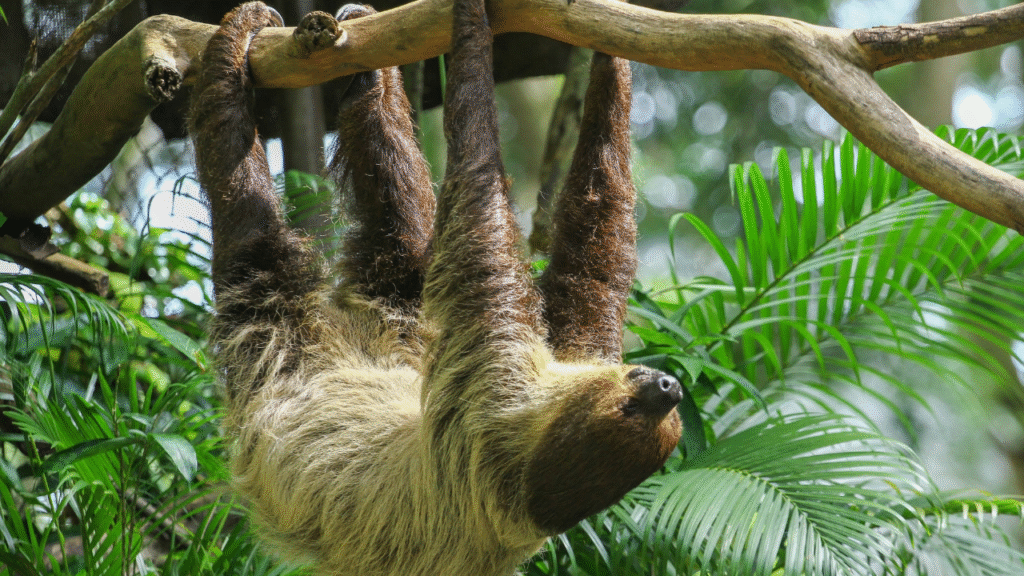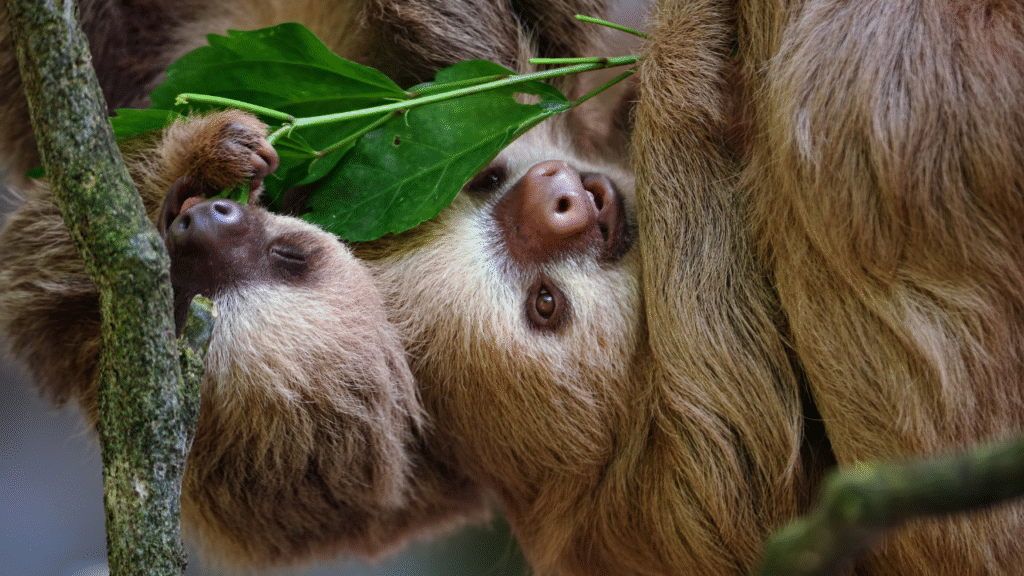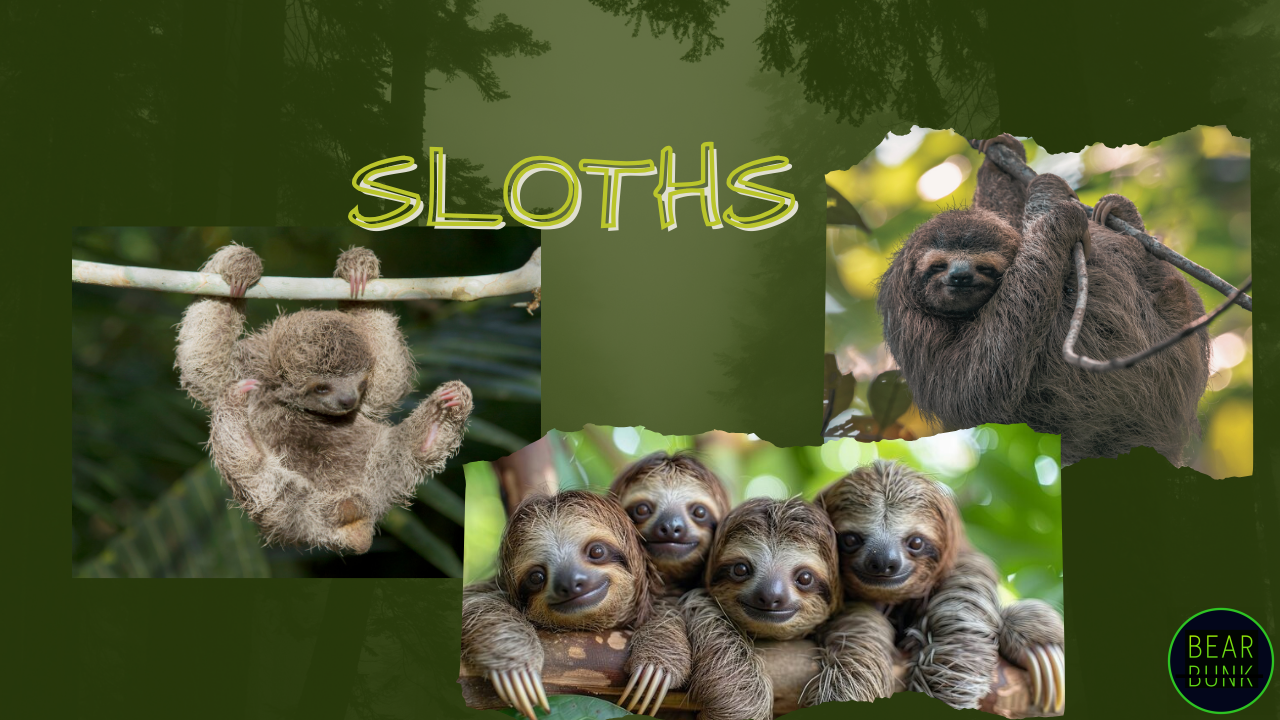Sloths: Nature’s Chillest Survival Experts
🦥Meet the Sloth
When it comes to surviving the rainforest, sloths do it their own way—slowly. These laid-back mammals defy expectations with bizarre behaviors and surprising superpowers, from algae-covered fur to swimming skills and some seriously strange bathroom habits.
They may not be fast, but sloths are fascinating.
Let’s take a closer look at these unhurried rainforest legends and what makes them so special.
Species
There are six known species of sloths, divided into two families:

Three-Toed Sloths (Bradypodidae):
These include the well-known brown-throated sloth, the maned sloth (which is endangered), the pale-throated sloth, and the pygmy three-toed sloth (critically endangered and found only on a single island in Panama).

Two-Toed Sloths (Choloepodidae):
These include Hoffmann’s two-toed sloth and Linnaeus’s two-toed sloth. They are generally larger, more nocturnal, and slightly faster than their three-toed cousins.
Interestingly, all sloths have three toes on their hind feet—the distinction actually refers to their fingers, not toes.
Habitat
Sloths are built for life in the trees. Found in the lush canopies of tropical rainforests across Central and South America, they move so slowly that moss and algae can grow on their fur—offering natural camouflage from predators like eagles and jaguars. They rarely come down to the forest floor unless absolutely necessary.
Diet
Sloths are herbivores with a low-energy, leaf-heavy diet. They munch on leaves, fruits, flowers, and buds—and their digestion is famously slow. It can take a sloth up to a month to fully digest a single meal. Their stomachs are multi-chambered and filled with bacteria that help break down tough plant fibers.
Mating & Raising Young
Sloths don’t rush romance. Mating often takes place in the trees, and after a gestation period of around six months, a mother sloth gives birth to a single baby. The baby clings to its mother’s belly for several months, learning the slow-and-steady lifestyle from the best. Two-toed sloths tend to be more active in breeding year-round, while some three-toed sloths follow more seasonal patterns.
Fun Facts About Sloths
- Algae-covered fur: It’s not just weird—it’s brilliant camouflage that helps them hide in the treetops.
- Living ecosystems: Their fur isn’t just green—it’s alive, often housing algae, moths, fungi, and even beetles.
- Swimming champs: Sloths are surprisingly agile in water. They can paddle across rivers and hold their breath for up to 40 minutes.
- Once-a-week bathroom breaks: Sloths descend from their trees only once a week to go to the bathroom. Scientists still aren’t sure why!
- Head-turning talent: Three-toed sloths can rotate their heads an impressive 270°, giving them a wide view of their treetop world.
- Super strong grip: Sloths can hang upside down for hours thanks to powerful muscles and hook-like claws.
About Sloths
Scientific Family: Bradypodidae (three-toed) and Choloepodidae (two-toed)
Number of Species: Six total (four three-toed, two two-toed)
Habitat: Tropical rainforests of Central and South America
Diet: Primarily leaves, shoots, fruit, and flowers
Lifespan: 20–30 years in the wild, up to 40+ in human care
Unique Traits: Algae grows on their fur, they can rotate their heads 270°, and they digest food extremely slowly
Social Structure: Solitary animals who spend most of their time in trees
Fun Fact: Sloth fur is its own ecosystem—home to algae, moths, and even tiny beetles!
Why We Love Them
Sloths are proof that you don’t have to move fast to make a lasting impression. From their adorable sleepy expressions to their unexpectedly resourceful survival skills, they remind us to slow down, enjoy the moment, and embrace life’s leafy naps.
They’re calm, quirky, and completely captivating.
Watch Our Full Sloth Video
🎥 Want even more sloth facts?
Check out our full video on YouTube:
Watch here
🐢 Want more laid-back legends like this one?
Check out our Slow Animals category to explore other creatures that thrive in the slow lane.
🌿 Curious about the jungle?
Visit our Rainforest Animals section for more wild facts and fascinating forest dwellers.
Takeaway
Sloths may live life in the slow lane, but they’ve carved out a winning strategy in one of the most competitive habitats on Earth. If you’re as enchanted by these fuzzy forest dwellers as we are, be sure to check out our other rainforest animals and subscribe for more amazing wildlife stories.
🦥💚 Respect the chill.






Leave a Reply